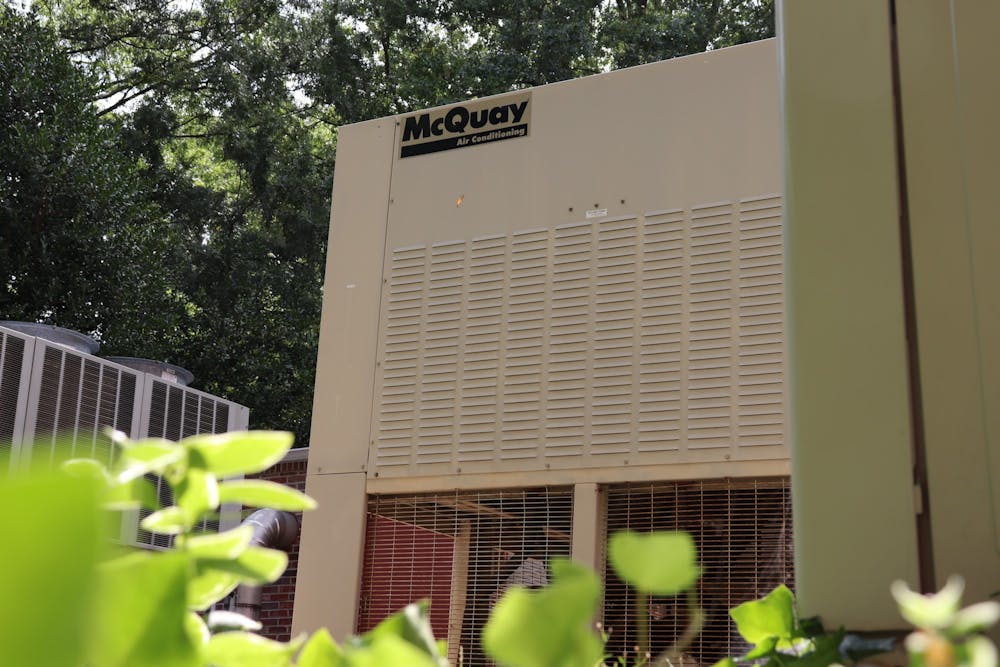You can’t see it. You can’t smell it. But it’s there. The air inside Elon University buildings is flowing at maximum capacity this year in order to mitigate the spread of COVID-19 on campus, according to Assistant Vice President of Physical Plant Tom Flood.
Physical Plant assessed each building’s unique heating, ventilation and air conditioning system over the summer, maximizing airflow while maintaining 40% to 60% humidity in each building, according to Flood. This level of humidity is ideal for limiting the spread of respiratory viruses, according to a recent study in the Annual Review of Virology.
In a statement to Elon News Network, Flood wrote that in the over 200 buildings on campus, a variety of HVAC systems are employed, and each was assessed on an individual basis with systems ranging from “typical” residential systems to “very complicated computer and sensor controlled systems for more complicated spaces.”
Buildings on campus are also now equipped with medical-grade air filters, Flood said. The new filters have a minimum efficiency reporting value of 13, compared to a residential-grade filter with a MERV rating of three to five. A higher rating correlates to finer filtration, meaning fewer particles remain in the air.
While air ventilation and filtration can be helpful, they are less necessary in fighting the spread of COVID-19 due to the nature of the virus, according to Dr. Jeffrey Hatcher of the Cone Health Regional Center for Infectious Disease. Air ventilation protects against aerosolized viruses, which Hatcher characterized as a virus that “hangs around the air.”
While air ventilation and filtration can be helpful, they are less necessary in fighting the spread of COVID-19 due to the nature of the virus, according to Dr. Jeffrey Hatcher of the Cone Health Regional Center for Infectious Disease. Air ventilation protects against aerosolized viruses, which Hatcher characterized as a virus that “hangs around the air.”
‘Things that are aerosolized would be more likely to go through duct systems and air conditioning systems and things like that,” Hatcher said. “So that we think that aerosolized spread for this virus is unlikely makes that seem a little bit less important in terms of having these different kinds of filters.”
While there is more concrete evidence that COVID-19 is spread through droplets rather than aerosols, aerosol transmission “cannot be ruled out,” according to the World Health Organization.
These filters are secondary to social distancing and wearing a mask in terms of mitigating the spread of COVID-19, Hatcher said, especially in closed rooms.
“Being in classrooms, it’s really incumbent on the people who are in those classrooms to do a good job of social distancing when they’re in those enclosed spaces,” Hatcher said. “So that’s certainly very difficult when you’re in college, social distancing isn’t probably the highest thing on your agenda.”
Hatcher added that focusing on classrooms doesn’t account for the majority of a student’s life.
“If you’re thinking about the risk just being in the classroom and that enclosed space, you’re really missing the opportunity to understand that other 23 hours of the day that is involved in student life,” Hatcher said, “whether it’s in the dorms or cafeteria or standing next to each other in the quad. So there’s lots of opportunities for us to intervene here.”
Freshman Meghan Malone said she feels comfortable in classrooms, especially with newly employed health maintenance measures.
“I think they are taking a lot of precautions,” Malone said, “so it doesn’t really bother me much.”
Flood said although staff with Physical Plant have taken measures to improve air flow and humidity in university buildings, much responsibility still lies with individuals to remain physically distant and wear their masks.
Other precautions against the virus include gathering outdoors instead of in the classroom. Tents are now stationed around campus for some classes.
“There are things that are going on outdoors that are protective for you,” Hatcher said, such as greater air circulation and UV light. “It’s not to say that you can’t spread the infection in people who are outdoors ... We just think about it as a little bit less common.”
Listen to this story on ENN Radio.
Though increased air flow outside can mitigate the spread of the coronavirus, opening windows to increase air flow in classrooms or other campus buildings is not always a good idea, according to Flood.
“While that may provide a short-term improvement in ventilation to a specific space, it negatively impacts the building system’s ability to filter the air and maintain comfortable conditions,” Flood wrote. “Leaving windows open while running the air conditioning for a prolonged period of days can also stimulate mold growth during our warm humid fall days.”
Physical Plant asks that individuals shut windows after using a space and avoid leaving residential windows open continuously, according to Flood.


